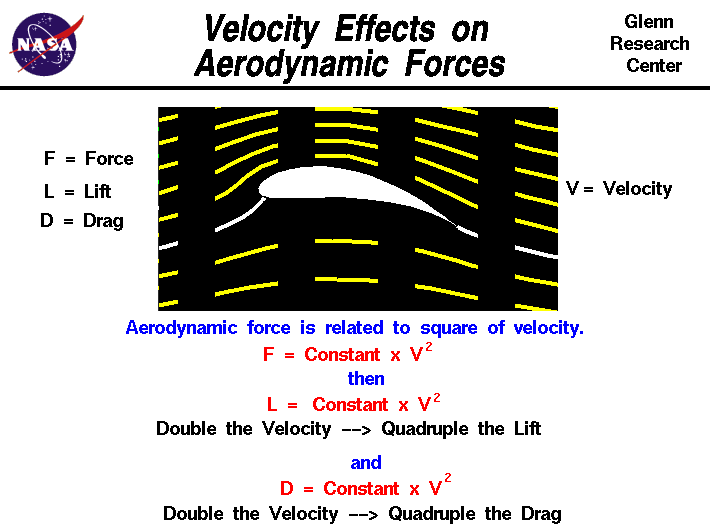
|
Investigating Velocity Effects at Takeoff
Problems
|

|
If so instructed by your teacher, print out a worksheet
page for these problems.
I. For each of the tables below:
- Determine the square of each velocity.
- Enter the data in the table.
- Start the
FoilSim
program.
a) Set the following conditions:
Airspeed = 100 mph
Altitude = 0 feet
Angle = 0 degrees
Thickness = 12.5%
Camber = 0
Area = 1.0 sq ft
b) Assume and enter the following for each aircraft:
Altitude = 0 feet
Angle = 0 degrees
Thickness = 12.5%
Camber = 5.0%
c) Enter the areas you determined for each aircraft (both
wings) from the Wing Area
Investigations Activity.
{Hint: Lift and Area are directly proportional. If the area
is over 1000 sq. ft., then divide it by 10 and enter that number.
When you get the lift, multiply it by 10 to get the real
value!}
- Record the lift generated by each entry in your table.

- Keeping in mind that the Lift is directly proportional
to the square of the Velocity, calculate and record the Constant
for each entry in each table.
|
Wright
Brothers
|
Area of two
wings:
|
|
|
Velocity:
|
Velocity
Squared:
|
Lift:
|
Constant:
|
|
0
|
|
|
|
|
25
|
|
|
|
|
50
|
|
|
|
|
75
|
|
|
|
|
100
|
|
|
|
|
125
|
|
|
|
|
150
|
|
|
|
|
175
|
|
|
|
|
200
|
|
|
|
|
225
|
|
|
|
|
250
|
|
|
|
|
F-18
|
Area of two
wings:
|
|
|
Velocity:
|
Velocity
Squared:
|
Lift:
|
Constant:
|
|
0
|
|
|
|
|
25
|
|
|
|
|
50
|
|
|
|
|
75
|
|
|
|
|
100
|
|
|
|
|
125
|
|
|
|
|
150
|
|
|
|
|
175
|
|
|
|
|
200
|
|
|
|
|
225
|
|
|
|
|
250
|
|
|
|
|
(Your
Aircraft)
|
Area of two
wings:
|
|
|
Velocity:
|
Velocity
Squared:
|
Lift:
|
Constant:
|
|
0
|
|
|
|
|
25
|
|
|
|
|
50
|
|
|
|
|
75
|
|
|
|
|
100
|
|
|
|
|
125
|
|
|
|
|
150
|
|
|
|
|
175
|
|
|
|
|
200
|
|
|
|
|
225
|
|
|
|
|
250
|
|
|
|
- Are the constants exactly the same for all entries in each
individual table? Why or why not? List possible sources of
error.
- Are the constant values the same for each aircraft? Discuss
and list some reasons for this.
II. Review the values entered in FoilSim.
- Which values were kept the same for all aircraft in this
activity?
- Which values differed from aircraft to aircraft in this
activity?
- The "Constant" values you calculated come from the values that
are held constant (not changed). Which values do you think are
included in the "Constant" value for each aircraft?
- Could these values ever be considered variables? If so, when
and how? If not, why not?
- Suppose your
aircraft is loaded with cargo and
extra fuel for a long flight so that it weighs 12500 pounds before
takeoff. What airspeed is needed to produce enough lift to get
your aircraft airborne? {Hint: On the ground the altitude and
angle are both zero. Also, use the same camber and thickness as
before since it's the same plane.}
|
